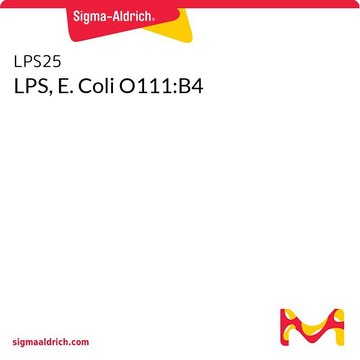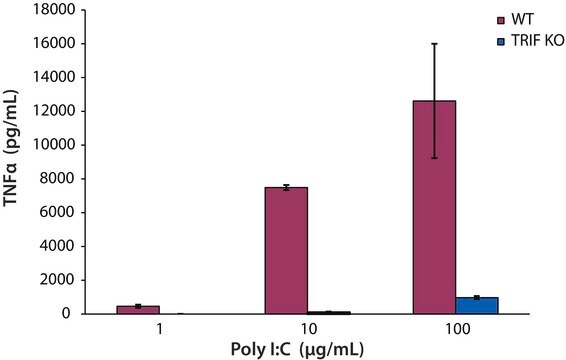L4130
Lipopolysaccharides from Escherichia coli O111:B4
purified by trichloroacetic acid extraction
Sinónimos:
LPS
Iniciar sesiónpara Ver la Fijación de precios por contrato y de la organización
About This Item
Productos recomendados
biological source
Escherichia coli (O111:B4)
Quality Level
form
lyophilized powder
purified by
trichloroacetic acid extraction
impurities
1-10% Protein (Lowry)
color
white to light yellow
solubility
water: soluble
shipped in
ambient
storage temp.
2-8°C
¿Está buscando productos similares? Visita Guía de comparación de productos
General description
This product is TCA extracted from E. coli serotype O111:B4. The source strain is from a private collection. This LPS serotype has been used to stimulate B-cells and induce NOS in human hepatocytes.
Application
Lipopolysaccharides (LPSs) are characteristic components of the cell wall of Gram-negative bacteria. LPS and its lipid A moiety stimulate cells of the innate immune system by the Toll-like receptor 4 (TLR4), a member of the Toll-like receptor protein family, which recognizes common pathogen-associated molecular-patterns (PAMPs).
Biochem/physiol Actions
Lipopolysaccharides (LPS) are localized in the outer layer of the membrane and are, in noncapsulated strains, exposed on the cell surface. They contribute to the integrity of the outer membrane, and protect the cell against the action of bile salts and lipophilic antibiotics.
Preparation Note
The product is soluble in water (5 mg/ml) or cell culture medium (1 mg/ml) yielding a hazy, faint yellow solution. A more concentrated, though still hazy, solution (20 mg/ml) has been achieved in aqueous saline after vortexing and warming to 70-80 oC. Lipopolysaccharides are molecules that form micelles in every solvent. Hazy solutions are observed in water and phosphate buffered saline. Organic solvents do not give clearer solutions. Methanol yields a turbid suspension with floaters, while water yields a homogeneously hazy solution.
Other Notes
To gain a comprehensive understanding of our extensive range of Lipopolysaccharides for your research, we encourage you to visit our Carbohydrates Category page.
related product
Referencia del producto
Descripción
Precios
signalword
Danger
hcodes
Hazard Classifications
Acute Tox. 2 Oral
Storage Class
6.1A - Combustible acute toxic Cat. 1 and 2 / very toxic hazardous materials
wgk_germany
WGK 3
flash_point_f
Not applicable
flash_point_c
Not applicable
Elija entre una de las versiones más recientes:
¿Ya tiene este producto?
Encuentre la documentación para los productos que ha comprado recientemente en la Biblioteca de documentos.
Los clientes también vieron
Lijia Chang et al.
The international journal of neuropsychopharmacology, 21(10), 932-937 (2018-06-13)
Although previous reports suggest sex-specific differences in the antidepressant actions of (R,S)-ketamine, these differences in the antidepressant actions of (R)-ketamine, which is more potent than (S)-ketamine, are unknown. Saline or (R)-ketamine was administered 23 hours post lipopolysaccharide administration to adult
Tobias Hilbert et al.
PloS one, 8(5), e65024-e65024 (2013-06-01)
IFNA1 (interferon alpha) is a key cytokine regulating the activity of numerous immune cells. Plasmacytoid dendritic cells (pDCs) as natural interferon-producing cells play critical roles as sensors of pathogens and link innate to adaptive immunity. CpG motifs within DNA sequences
Wei Yao et al.
European journal of pharmacology, 793, 21-27 (2016-11-07)
The Nuclear factor (erythroid 2-derived)-like 2 (Nrf2) plays a key role in inflammation which is implicated in the pathophysiology of depression. The Nrf2 activators have antidepressant effects in animal models of depression. The present study was undertaken to examine whether
Marie Hilderman et al.
Clinical kidney journal, 8(5), 599-605 (2015-09-29)
The cholinergic anti-inflammatory pathway (CAP) modulates inflammatory responses through the vagus nerve and the α-7-nicotinic acetylcholine receptor (α7nAChR) on macrophages and immune cells. Sympathetic/parasympathetic imbalance and chronic inflammation are both linked to poor outcome in dialysis patients. The aim of
A Bruchfeld et al.
Journal of internal medicine, 268(1), 94-101 (2010-03-27)
The central nervous system regulates innate immunity in part via the cholinergic anti-inflammatory pathway, a neural circuit that transmits signals in the vagus nerve that suppress pro-inflammatory cytokine production by an alpha-7 nicotinic acetylcholine receptors (alpha7nAChR) dependent mechanism. Vagus nerve
Nuestro equipo de científicos tiene experiencia en todas las áreas de investigación: Ciencias de la vida, Ciencia de los materiales, Síntesis química, Cromatografía, Analítica y muchas otras.
Póngase en contacto con el Servicio técnico





